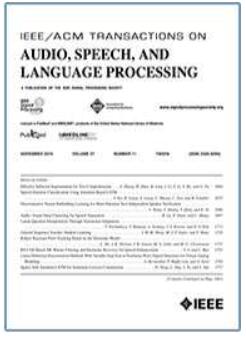语音增强的跨域优化:并行还是级联?
IF 5.1
2区 计算机科学
Q1 ACOUSTICS
IEEE/ACM Transactions on Audio, Speech, and Language Processing
Pub Date : 2024-09-26
DOI:10.1109/TASLP.2024.3468026
引用次数: 0
摘要
本文介绍了用于语音增强的五种新型深度学习架构。现有方法通常使用时域、时频表示或混合方法。认识到每个域对特征提取和模型设计的独特贡献,本研究探讨了通过跨域融合来整合波形和复杂频谱模型,以增强语音特征学习和降噪,从而提高语音质量。我们研究了波形和复杂频谱图模型的级联和并行配置,以评估它们在语音增强中的有效性。此外,我们还采用了基于正交投影的误差分解技术,并对各个子模型的输入进行管理,以分析影响语音质量的因素。我们通过优化应用于所有子模型的三个特定损失函数来训练网络。我们使用 DNS Challenge(ICASSP 2021)数据集进行的实验表明,所提出的模型超越了语音增强方面的现有基准,提供了卓越的语音质量和可懂度。这些结果凸显了我们的跨域融合策略的功效。本文章由计算机程序翻译,如有差异,请以英文原文为准。
Cross Domain Optimization for Speech Enhancement: Parallel or Cascade?
This paper introduces five novel deep-learning architectures for speech enhancement. Existing methods typically use time-domain, time-frequency representations, or a hybrid approach. Recognizing the unique contributions of each domain to feature extraction and model design, this study investigates the integration of waveform and complex spectrogram models through cross-domain fusion to enhance speech feature learning and noise reduction, thereby improving speech quality. We examine both cascading and parallel configurations of waveform and complex spectrogram models to assess their effectiveness in speech enhancement. Additionally, we employ an orthogonal projection-based error decomposition technique and manage the inputs of individual sub-models to analyze factors affecting speech quality. The network is trained by optimizing three specific loss functions applied across all sub-models. Our experiments, using the DNS Challenge (ICASSP 2021) dataset, reveal that the proposed models surpass existing benchmarks in speech enhancement, offering superior speech quality and intelligibility. These results highlight the efficacy of our cross-domain fusion strategy.
求助全文
通过发布文献求助,成功后即可免费获取论文全文。
去求助
来源期刊

IEEE/ACM Transactions on Audio, Speech, and Language Processing
ACOUSTICS-ENGINEERING, ELECTRICAL & ELECTRONIC
CiteScore
11.30
自引率
11.10%
发文量
217
期刊介绍:
The IEEE/ACM Transactions on Audio, Speech, and Language Processing covers audio, speech and language processing and the sciences that support them. In audio processing: transducers, room acoustics, active sound control, human audition, analysis/synthesis/coding of music, and consumer audio. In speech processing: areas such as speech analysis, synthesis, coding, speech and speaker recognition, speech production and perception, and speech enhancement. In language processing: speech and text analysis, understanding, generation, dialog management, translation, summarization, question answering and document indexing and retrieval, as well as general language modeling.
 求助内容:
求助内容: 应助结果提醒方式:
应助结果提醒方式:


